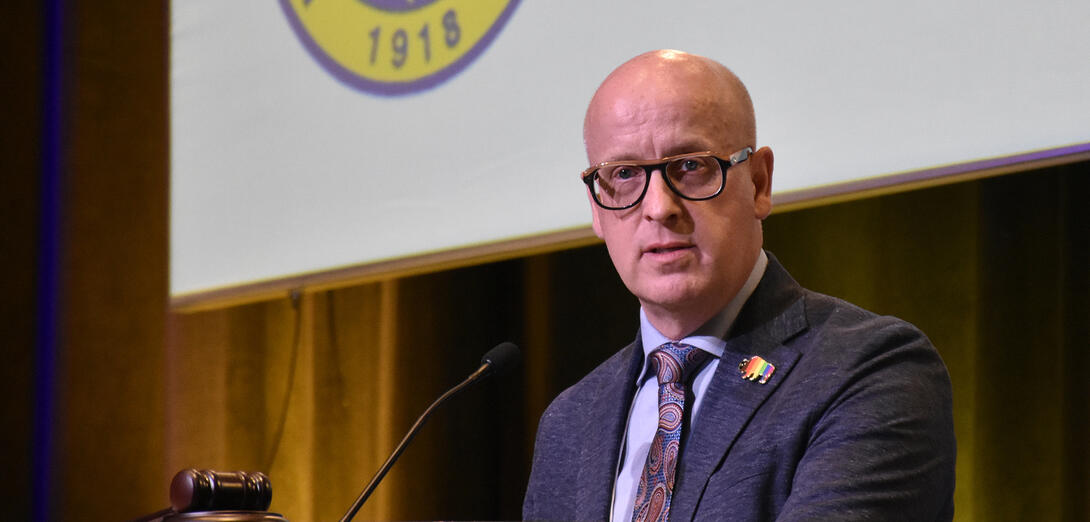Diversity was a prominent theme throughout the May long weekend as 450 teacher delegates gathered in Calgary for the ATA’s Annual Representative Assembly.
Delegates passed a series of resolutions that will significantly change the ATA’s approach to issues related to diversity, equity and human rights (DEHR).
Significant amongst them is resolution 3-29 which will provide funding for the creation of diversity equity networks (DENs). Modelled on ATA specialist councils, these networks will provide a structure within which teachers of a diverse group can come together to dialogue, support each other and organize relevant events and services. Where specialist councils focus on what or who a teacher teaches, DENs will focus on how a teacher identifies personally.
“Five years from now, somebody is going to ask where were you when the DENs were created in the ATA?” said one delegate. “And you want to be able to say, ‘I was there, I was a part of that, I made that happen.’”
“What this is, is an opportunity to acknowledge that diversity equity and inclusion are our moral duties,” said another delegate. “All teachers experience intersections that can be addressed by DENs. Teachers may be directly impacted by diversity because of their own identity or may be impacted because of the diversity needs of their students.”
Other diversity-related resolutions also evoked passionate speeches during debates. Resolution 2-22 funds a third-party equity audit for the Association; 3-28 creates two annual seminars for local DEHR chairs; 3-33 creates an Indigenous education initiatives grant; 3-30 provides support for hosting the CTF Women’s Symposium in Alberta; and 3-21 adds a new Professional Development staff officer who will provide support to DENs and other diversity initiatives.
Resolution 4-1 aims to protect the rights of teachers to display Pride materials in their classrooms, after several school boards have made teachers remove their displays.
“Supportive and affirming Pride materials, like posters, stickers, flags etc., can be seen and experienced as beacons of hope,” said one delegate speaking on resolution 4-1. “Our students look for the symbols. They look for them, and when they are absent, or even worse, when they are removed, it is noticed, it is internalised, and it decreases feelings of safety, representation and opportunities for education.”
A number of other diversity-related resolutions that passed (3-20, 3-12, 3-13, 3-8) protect teacher autonomy around GSAs, selecting resources and providing support and protection to diverse students. Other resolutions responded to issues stemming from the government’s planned legislation impacting how 2SLGBTQ+ students are supported in schools, including changing names and pronouns (3-18/19), the use of the notwithstanding clause to pass legislation (3-5), parental notification (2-16) and preserving the privacy of children (3-6/7).
Impact of underfunding
During the debate on resolution 3-45, delegates spent nearly 90 minutes passionately sharing stories about how underfunding has impacted their classrooms and schools. That resolution states, “Alberta’s students deserve better than to have the lowest-funded public education system in Canada,” and calls for the government to restore per-student funding to the national average.
“Principals are being put in impossible situations, and I am getting tired of having those conversations with my teachers,” said one school principal. “I am a principal of a small school, 200 students. I could have hired an extra three to three-and-a-half teachers in my school if we were just funded at the average level.”
Another delegate shared some words from one of her students who happened to see the resolution on her desk and wanted to write a response to it.
“In my class alone, there are 39 Grade 7 students, and many of us need extra help,” read the teacher. “Imagine needing help, and there’s no one available to assist you. That’s our reality. This lack of support often leads to feelings of frustration and apathy.”
“When students don’t receive the help they need, they can start to feel like their education doesn’t matter, and they might give up trying altogether. I think some of my classmates already have.”
Cellphones and other resolutions
Another resolution (3-43) that received significant attention calls for the prohibition of smartphones in classes unless there is a defined pedagogical, digital wellness or medical purpose to their use. The resolution was passed with strong support.
Education Minister Demetrios Nicolaides has launched a survey on cellphone use and is open to legislating a ban. Governments in British Columbia, Ontario and Quebec have already implemented cellphone restrictions.
“New research shows that if you are a teenager in Alberta, you will get, on average, 192 notices a day from your social media feeds, so it is no surprise that they are reaching for their devices all the time,” reported one delegate. “Our resolution is important as it aims to ensure that when a restriction is introduced, teacher professional judgment remains at the forefront of all decisions related to smartphone use in Alberta classrooms and schools.”
The assembly also passed resolutions relating to the Canada Pension Plan, the draft social studies curriculum, political parties in school board elections, actions that limit student protestors and the protection of education institutions during global conflicts. ❚



